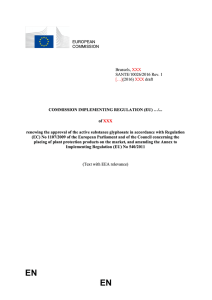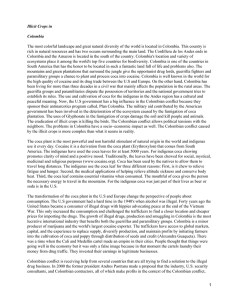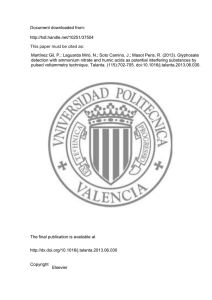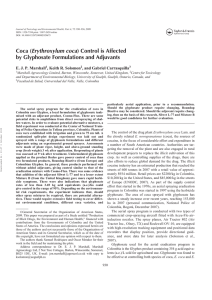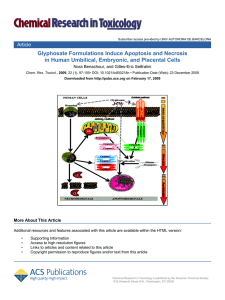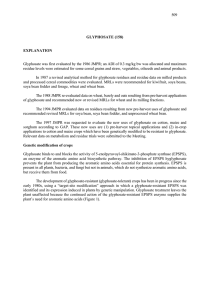Human Health and Environmental Risks from the Use of Glyphosate
Anuncio
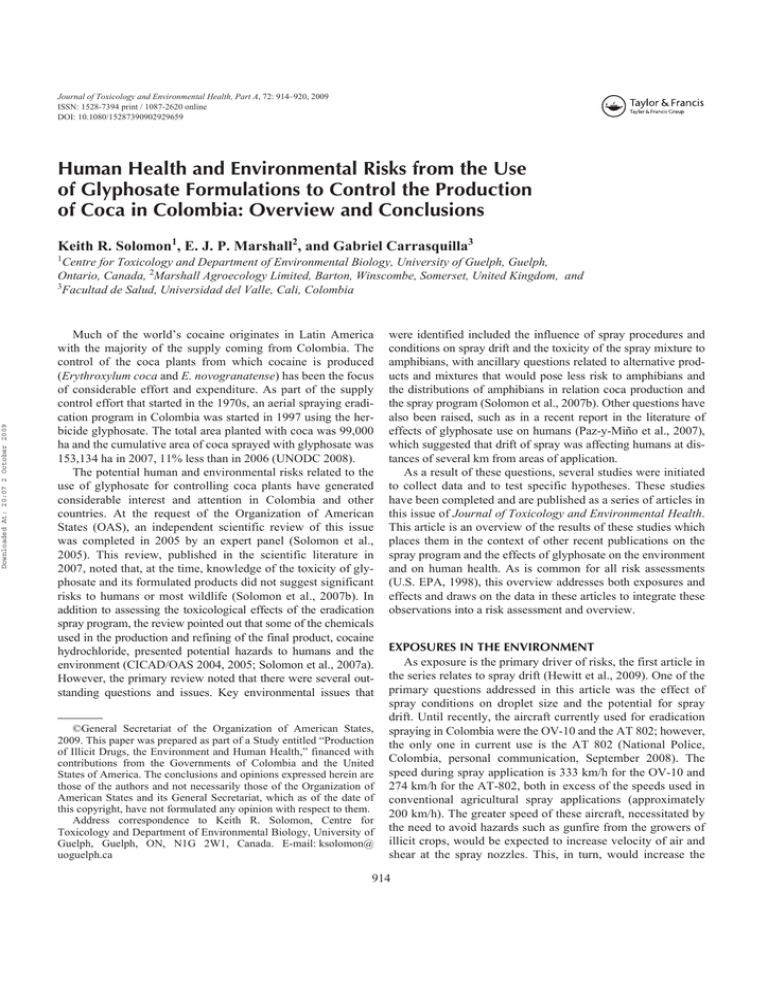
Journal of Toxicology and Environmental Health, Part A, 72: 914–920, 2009 ISSN: 1528-7394 print / 1087-2620 online DOI: 10.1080/15287390902929659 Human Health and Environmental Risks from the Use of Glyphosate Formulations to Control the Production of Coca in Colombia: Overview and Conclusions UTEH Keith R. Solomon1, E. J. P. Marshall2, and Gabriel Carrasquilla3 Overview: Human Health and Glyphosate Formulations 1 Downloaded At: 20:07 2 October 2009 Centre for Toxicology and Department of Environmental Biology, University of Guelph, Guelph, Ontario, Canada, 2Marshall Agroecology Limited, Barton, Winscombe, Somerset, United Kingdom, and 3 Facultad de Salud, Universidad del Valle, Cali, Colombia Much of the world’s cocaine originates in Latin America with the majority of the supply coming from Colombia. The control of the coca plants from which cocaine is produced (Erythroxylum coca and E. novogranatense) has been the focus of considerable effort and expenditure. As part of the supply control effort that started in the 1970s, an aerial spraying eradication program in Colombia was started in 1997 using the herbicide glyphosate. The total area planted with coca was 99,000 ha and the cumulative area of coca sprayed with glyphosate was 153,134 ha in 2007, 11% less than in 2006 (UNODC 2008). The potential human and environmental risks related to the use of glyphosate for controlling coca plants have generated considerable interest and attention in Colombia and other countries. At the request of the Organization of American States (OAS), an independent scientific review of this issue was completed in 2005 by an expert panel (Solomon et al., 2005). This review, published in the scientific literature in 2007, noted that, at the time, knowledge of the toxicity of glyphosate and its formulated products did not suggest significant risks to humans or most wildlife (Solomon et al., 2007b). In addition to assessing the toxicological effects of the eradication spray program, the review pointed out that some of the chemicals used in the production and refining of the final product, cocaine hydrochloride, presented potential hazards to humans and the environment (CICAD/OAS 2004, 2005; Solomon et al., 2007a). However, the primary review noted that there were several outstanding questions and issues. Key environmental issues that ©General Secretariat of the Organization of American States, 2009. This paper was prepared as part of a Study entitled “Production of Illicit Drugs, the Environment and Human Health,” financed with contributions from the Governments of Colombia and the United States of America. The conclusions and opinions expressed herein are those of the authors and not necessarily those of the Organization of American States and its General Secretariat, which as of the date of this copyright, have not formulated any opinion with respect to them. Address correspondence to Keith R. Solomon, Centre for Toxicology and Department of Environmental Biology, University of Guelph, Guelph, ON, N1G 2W1, Canada. E-mail: ksolomon@ uoguelph.ca were identified included the influence of spray procedures and conditions on spray drift and the toxicity of the spray mixture to amphibians, with ancillary questions related to alternative products and mixtures that would pose less risk to amphibians and the distributions of amphibians in relation coca production and the spray program (Solomon et al., 2007b). Other questions have also been raised, such as in a recent report in the literature of effects of glyphosate use on humans (Paz-y-Miño et al., 2007), which suggested that drift of spray was affecting humans at distances of several km from areas of application. As a result of these questions, several studies were initiated to collect data and to test specific hypotheses. These studies have been completed and are published as a series of articles in this issue of Journal of Toxicology and Environmental Health. This article is an overview of the results of these studies which places them in the context of other recent publications on the spray program and the effects of glyphosate on the environment and on human health. As is common for all risk assessments (U.S. EPA, 1998), this overview addresses both exposures and effects and draws on the data in these articles to integrate these observations into a risk assessment and overview. EXPOSURES IN THE ENVIRONMENT As exposure is the primary driver of risks, the first article in the series relates to spray drift (Hewitt et al., 2009). One of the primary questions addressed in this article was the effect of spray conditions on droplet size and the potential for spray drift. Until recently, the aircraft currently used for eradication spraying in Colombia were the OV-10 and the AT 802; however, the only one in current use is the AT 802 (National Police, Colombia, personal communication, September 2008). The speed during spray application is 333 km/h for the OV-10 and 274 km/h for the AT-802, both in excess of the speeds used in conventional agricultural spray applications (approximately 200 km/h). The greater speed of these aircraft, necessitated by the need to avoid hazards such as gunfire from the growers of illicit crops, would be expected to increase velocity of air and shear at the spray nozzles. This, in turn, would increase the 914 Downloaded At: 20:07 2 October 2009 OVERVIEW: HUMAN HEALTH AND GLYPHOSATE FORMULATIONS formation of small droplets with a greater propensity for drift and offsite damage. Currently, exposure characterization is conducted by using models such as AGDISP (Bilanin et al., 1989) and AgDRIFT (Hewitt et al., 2001) for predicting onand off-target deposition of aerially applied sprays of pesticides. However, data on droplet size under spray conditions in Colombia to input into the models were lacking. Data on droplet size spectra were measured in a unique wind tunnel facility in Australia where the appropriate velocity of air could be achieved, and these data were then used to model spray drift in relation to sensitive organisms (Hewitt et al., 2009). These results showed that the tank mix of Glyphos and Cosmo-Flux, as used in the eradication spraying in Colombia, produced droplets of median diameter (Dv0.5) of 128 to 140 µm, which are classified as very fine to fine sprays. Modeling of spray drift using AgDRIFT showed that the spray droplets would not evaporate as rapidly as most similarly sized agricultural sprays because of the large proportion of nonvolatile components (active and inert adjuvant ingredients). Thus, even under worst-case conditions of a cross-wind of 9.3 km/h, the potential for longer range drift was small and most drift that might occur would deposit relatively close to the application swath. In addition, drift only occurs downwind and with winds of velocity less than the modeled maximum the drift distance would be less. Based on worst-case spray drift at various distances from the application swath, exposures of plants and organisms in shallow water (15 cm deep) were estimated and compared to species sensitivity distributions of toxicity values for formulations of glyphosate in plants and amphibians, the most sensitive group of animals. Based on modeled drift and 5th centile concentrations, which would be protective of 95% of plants, appropriate nospray buffer zones (distance from the end of the spray boom as recorded electronically ±5%) were 50 m to 120 m for coca spraying. These buffers are additionally protective of plants, as it was shown that, at small rates of application, glyphosate stimulates plant growth (Velini et al., 2008), which, even in the long term, does not reduce yields (Cedergreen, 2008). The equivalent buffer zone for protection of amphibia in shallow water was 5 m, which, as discussed later, is conservative because adsorption of glyphosate and formulants in the mixture to sediments and particulate matter further reduces exposures and therefore, risk. The low toxicity of glyphosate and its formulations to mammals (Williams et al., 2000; Solomon et al., 2007b) suggests that these aerial applications are not a concern to bystanders, even those close to the spray swath. The assertion that spray drift over long distances was adversely affecting humans (Paz-y-Miño et al., 2007) is not supported by these observations, as exposures would be extremely small. For example, at 1 km from the spray swath, deposition would be between 1 and 0.1 g glyphosate acid equivalents (a.e.)/ha, which is equivalent to between 0.57 and 0.06 µg/kg body weight (bw), assuming a total exposed skin area for a naked 70-kg human of 2 m2 and 2% penetration (Solomon et al., 915 2007b). This is between 175- and 1750-fold less than the chronic reference dose of 100 µg/kg/day as determined by the U.S. Environmental Protection Agency (EPA) (2008) and between 3500- and 58,000-fold less than the acceptable operator exposure level (AOEL) of 200 µg/kg/d (IUPAC, 2009). EFFECTS IN THE ENVIRONMENT With regard to effects on organisms in the environment, the initial review (Solomon et al., 2007b) noted that amphibians appeared to be relatively more sensitive to formulations of glyphosate than other aquatic animals, however, there were no data for the mixture of Glyphos and Cosmo-Flux as used for coca eradication in Colombia. It was also noted that many other pesticides were used in the production of coca and that these could present significant risks to humans and non-target organisms in the environment (Solomon et al., 2007a). Based on a worst-case exposure scenario, and a quotient based on the reference dose, some of the chemicals used by growers, particularly the organophosphorus insecticides, had hazard quotients for humans 2000-fold greater than that for the eradication spray (Solomon et al., 2007a). Similarly, hazards to all aquatic organisms were up to 20,000-fold greater (for endosulfan) than the eradication spray mixture (Solomon et al., 2007a). A refinement of this approach that focused on amphibians (Brain & Solomon, 2009) is published in this issue and confirmed the greater hazards to amphibians of the chemicals used to produce coca. For some species of larval amphibians, sensitivity to several pesticides (mainly insecticides) was 10- to 1000-fold greater than estimated worst-case exposures and hazards were much greater than those for the eradication spray mixture. In addition, habitat destruction, such as clear-cutting forests for production of coca or food crops, was identified as another major threat to amphibians (Brain & Solomon, 2009; Lynch & Arroyo, 2009). As there were no data on the susceptibility of amphibians to the mixture of Glyphos and Cosmo-Flux used in the eradication sprays, this was also a focus in the collection of additional data. An initial lab study with the African clawed frog, Xenopus laevis (Wildlife International, 2006a, 2006b), showed that the mixture was somewhat less toxic than reported values for other formulations of glyphosate. The LC50 for the mixture as used on coca was the equivalent of 1100 (95% CI; 560-2,300) µg glyphosate a.e./L, while the lowest LC50 previously reported for formulated glyphosate (Vision) in the same species of frog was 800 µg a.e./L (Edginton et al., 2004). This then raised two questions; the first was whether there were alternative formulations of glyphosate that were potentially less toxic to frogs but as effective as the currently used mixture for the control of coca and, second, were Colombian frogs generally more or less sensitive to formulated glyphosate than other species tested in other regions? To investigate the efficacy of other formulations of glyphosate on coca, field trials were conducted in Tolima Department, Downloaded At: 20:07 2 October 2009 916 K. R. SOLOMON ET AL. Colombia (Marshall et al., 2009). Coca plants (E. coca) were grown from seedlings to 75 cm height and then sprayed with a range of glyphosate formulations and different adjuvants using an experimental ground sprayer. Assessments were made of plant vigor, height, and above-ground standing crop (fresh weight) 3 wk after application. Resprouting of plants was assessed at 9 wk after treatment. Even mixed with adjutants, unformulated glyphosate applied as the product Rodeo gave poorer control of coca than two formulated products, Roundup Biactive (from Europe) and the formulation currently used in eradication spraying, Glyphos. In general, these latter two products performed well without added adjuvants, giving control similar to that of the mixture of Glyphos and Cosmo-Flux as currently used in Colombia. There was some evidence that addition of the adjuvant Silwet L-77 and, to a lesser extent, Mixture B (from the United Kingdom) resulted in the earlier appearance of symptoms of injury. There were also indications that glyphosate rates of less than 3.7 kg a.e./ha provided control in the range of 95%. When also considering that glyphosate appears to inhibit the production of cocaine in coca plants (Casale & Lydon, 2007), effective control of drug production may be possible with lower rates of application. These results also illustrate that there are potential alternatives to currently used products, one of which, Roundup Biactive, was shown to be less toxic to amphibians (Mann et al., 2003). Before using these products, field testing to assess the influence of different environmental conditions, varieties of coca, and aerial application procedures needs to be conducted. Should a different adjuvant be required, Silwet L-77 and Mixture B would be good candidates for further evaluation, including toxicity to nontarget organisms. To address the question of sensitivity of Colombian species of frogs to formulated glyphosate, a series of toxicity bioassays was conducted on tadpoles under laboratory conditions (Bernal et al., 2009a). Laboratory studies were conducted in glass containers and in the absence of sediments and particulate matter. LC50 values for the 8 species tested (Gosner stage-25 tadpoles of Scinax ruber, Dendrosophus microcephalus, Hypsiboas crepitans, Rhinella granulosa, R. marina, R. typhonius, Centrolene prosoblepon, and Engystomops pustulosus) ranged from 1200 to 2780 µg glyphosate a.e./L. These values suggest that sensitivity to Roundup-type formulations of glyphosate in these species is similar to that observed in other tropical and temperate species of frogs for which data have been published in the literature. The toxicity of the mixture of Glyphos and Cosmo-Flux as used to spray coca was likely driven by the surfactant in the Glyphos, as the addition of Cosmo-Flux did not increase toxicity above those values reported in other frogs for studies using both Vision and Roundup, two similar formulations used in North America (discussed earlier). Cosmo-Flux is of low toxicity to fish with an LC50 of 4417 mg formulation/L (RondonBarragan et al., 2007). That tropical frog species were of similar sensitivity to those from temperate regions is also consistent with observations with other pesticides and other organisms (Maltby et al., 2005) and therefore allows the combination of Colombian data with those from other regions for the purposes of risk assessment. In contrast to laboratory observations, toxicity studies conducted on Gosner stage 25 tadpoles under field conditions in 15-cm deep microcosms containing a 3-cm layer of sediment showed reduced sensitivity (Bernal et al., 2009b). Microcosms were sprayed with the mixture of Glyphos and Cosmo-Flux as used in eradication spraying. Mortality >50% was only observed in the tested species when the application rates were >2-fold the normal application rate of 3.69 kg glyphosate a.e./ha. LC50 values were between 8.9 and 10.9 kg glyphosate a.e./ha (equivalent to initial nominal concentrations of 5963 to 7303 µg glyphosate a.e./L in the microcosms. These results show that toxicity of the spray mixture is reduced in the presence of sediments and particulates in the water column. Although it was not possible to measure concentrations of glyphosate in these systems, the reduction in toxicity was similar to that observed by others (Tsui & Chu, 2003, 2004, 2008; Tsui et al., 2005) for the formulated product and also for the POEA surfactant, which contributes the greatest to the toxicity of the formulation (Wang et al., 2005). In these studies, reductions in toxicity were attributed to reductions in exposure as a result of absorption to sediments and/or breakdown by microbes. Thus, risks to larval frogs (representing sensitive aquatic organisms) from the eradication sprays as used in Colombia would be reduced by adsorption to sediments under field conditions and, even with direct overspray, amphibians in shallow water systems (∼15 cm deep and theoretically the most vulnerable) would be at low risk. In bioassays where terrestrial stages of frogs (juveniles and adults) were exposed to a direct overspray of the Glyphos– Cosmo-Flux mixture, LC50 values ranged between 4.5 and 22.8 kg a.e./ha, all of which were above the application rate of 3.7 kg a.e./ha for eradication spraying. These studies were conducted under realistic conditions with soil and leaf litter present in the bottom of the exposure chambers, a different exposure system from that used in other studies that claimed high toxicity of formulated glyphosate (Relyea, 2005). The observations of Relyea (2005) on adult frogs may have been the result of the presence of formulants specific to the product used (Dinehart et al. 2009) or incorrect calculation of exposures as the results reported by Bernal et al. (2009a) are consistent with those of Mann and Bidwell (1999), who observed that adult and juvenile terrestrial stages of the Australian frog, Crinia insignifera were less sensitive to Roundup than tadpoles. The overall conclusions of the studies on Colombian frogs are that, under worst-case exposure conditions, the mixture of Glyphos and Cosmo-Flux used for control of coca in Colombia is of low or negligible risk to aquatic and juvenile terrestrial stages of frogs. To provide background information on amphibians and their distribution in relation to coca production and aerial eradication spraying in Colombia, data on the more than 53,000 records of amphibians in the Instituto de Ciencias Naturales Downloaded At: 20:07 2 October 2009 OVERVIEW: HUMAN HEALTH AND GLYPHOSATE FORMULATIONS (ICN) (Bogotá) were characterized (Lynch & Arroyo, 2009). Analyses were based on the proximities of actual museum records to localities in which illegal crops are being grown and the subset of those that have been sprayed with glyphosate. ARC MAP software was used so that direct distance separating of collection locations for frogs, known coca fields, and areas where aerial spraying was being conducted could be measured (Lynch & Arroyo, 2009). Based on data for the location of amphibians collected in Colombia, records existed of 193 species (28% of the national diversity) of frogs and toads from localities within 10 km of areas where coca is grown. Records in or near coca fields included records for 13 of the 15 families of frogs and toads known for Colombia. Only Ceratophryidae and Pipidae were not reported from these locations and would not be at risk. For eight species (Dendrobates truncatus, Craugastor raniformis, Pristimantis gaigeae, Smilisca phaeota, Elachistocleis ovale, Hypsiboas crepitans, Trachycephalus venulosus, and Pseudis paradoxa) selected to represent several coca-associated habitat preferences and lifecycle strategies, large areas of their distributions lie outside coca production regions and the populations as a whole are at low risk of exposure. For a limited number of species that barely enter Colombian territory, the consequences of coca production may be more serious and may have placed several species of frogs at risk. These include Ameerega bilingua, Dendropsophus bifurcus, Eleutherodactylus colomai, E. degener, E. diadematus, E. quaquaversus, E. variablis, and Trachycephalus jordani. Other species may be at risk, but exact numbers are unknown because little investigation occurred in these areas during the past 30 yr. As these species are found in Ecuador, it is assumed that healthy populations persist there. Overall, the risks from pesticide used for eradication spraying must be placed in the context of the greater toxicity of other products used by growers (Brain & Solomon, 2009) and the sensitivity of frogs from Colombia to the mixture of glyphosate and Cosmo-Flux as used in the aerial eradication spraying. Laboratory-based toxicity studies showed that aquatic larval stages of Colombian species are not differently sensitive as compared with frogs from other locations (Bernal et al., 2009b). When tested under realistic conditions—in shallow water (15 cm deep) in the presence of sediment and particulates that will absorb glyphosate and the more toxic surfactant—toxicity was reduced (Bernal et al., 2009b), resulting in lower risk. In contrast, some of the products used by growers may be more bioavailable in the environment and risks to these may not be mitigated. Terrestrial stages were less susceptible than aquatic stages (Bernal et al., 2009b). Modeling of spray drift from the aerial eradication spraying (Hewitt et al., 2009) showed small downwind exposures to the mixture of glyphosate and Cosmo-Flux at distances beyond 30 m. Based on laboratory toxicity data, larval stages of frogs would only be at risk if they were in shallow water within 5 m of the spray swath. However, under conditions of exposure in the field, 917 interception by foliage and adsorption to soils and sediments reduce exposures still further, and risks, even to a direct mixtures of the eradication mixtures, are small to negligible. EFFECTS IN HUMANS In previous reviews of the risk of glyphosate to humans, it was concluded that both the active ingredient and the formulated product (Roundup) present low risks to humans whether used in agricultural or vegetation management (Williams et al., 2000) or as used in the eradication of coca in Colombia (Solomon et al., 2007b). The first article in this series on the potential human health effects of the use of Glyphos and Cosmo-Flux for the eradication of coca addressed the issue of possible reproductive effects of the spray program in Colombia (Sanin et al., 2009). This issue was identified as a possible response by earlier reports of associations between pesticides and reproductive outcomes. Arbuckle et al. (2001) reported moderate increases in the risk of early abortion when preconception self-reported exposures to phenoxy acetic acid herbicides were present and for late abortions and self-reported preconception exposure to glyphosate was associated with higher risks. In another study, Curtis et al. (1999) showed a positive association (decrease in fecundability of 20% or more) measured through time to pregnancy (TTP) when both spouses reported exposure to pesticide-related activities, one of which was glyphosate. The study in Colombia was to test whether there was an association between the use of glyphosate when applied by aerial spray for the eradication of illicit crops eradication (cocaine and poppy) and time to pregnancy (TTP) among fertile women. The study was a retrospective cohort study with an ecological exposure index related to areas of residence with different uses of glyphosate. First pregnancies in 2592 fertile women from 5 regions were included in the study and the women were interviewed regarding potential reproductive, lifestyle and work history predictors of TTP. The results showed that there were differences in TTP between regions. Boyacá, a region with traditional crops without glyphosate eradication spraying (manual eradication), had the minimal risk and was the reference region. Sierra Nevada, a control area with organic agriculture and no pesticide use; Putumayo, where illicit crops are grown and with an intensive eradication spray program; and Valle del Cauca, a sugar cane region where glyphosate and others chemicals have been used for more than 30 yr, had greater risk of longer TTP, with the highest risk for Valle del Cauca (Sanin et al., 2009). Classification of exposure in the study was by location of residence. Nonexposed participants were those who lived in the region where organic crops were produced and who, in addition, did not report any use of pesticides in the interview. In the other four departments, there was exposure not only to glyphosate, but also to other herbicides and pesticides. Although place of residence is not an accurate surrogate for Downloaded At: 20:07 2 October 2009 918 K. R. SOLOMON ET AL. exposure to pesticides and may generate misclassification (Arbuckle et al., 2004), this ecological assessment was useful to explore, at the population level, whether an association existed between the putative exposure (aerial spraying of glyphosate) and outcome (Ritter et al., 2006). Pesticides in general are likely not the cause of observed differences either. Large differences in TTP were found between two regions of high to moderate pesticide use, Valle del Cauca and Boyacá. The observed ecological differences remain unexplained, but may be produced by varying exposures to environmental factors, history of contraceptive programs in the region, or psychological distress. Future studies examining these alternative causes are needed. Epidemiological studies have not shown consistent or strong relationships between glyphosate exposures and health outcomes. Glyphosate and its formulations have been extensively investigated for potential adverse effects in humans (Williams et al., 2000). They have been reported to exert a low acute toxicity to different animal species. Chronic feeding studies have not shown evidence of carcinogenicity or any other relevant long-term effect (U.S. EPA, 1993; World Health Organization International Program on Chemical Safety, 1994). Glyphosate AI and Roundup were extensively tested for genotoxicity in a wide range of in vitro and in vivo systems evaluating different genetic endpoints (gene mutation, chromosome mutation, DNA damage and repair) using bacteria and mammalian somatic cells (Williams et al., 2000). Although effects were reported in some in vitro studies, it was concluded that, in vivo, glyphosate and its formulations were not genotoxic (Williams et al., 2000). Several in vitro and in vivo studies with parallel testing of glyphosate AI and Roundup showed that only the commercial formulation was genotoxic (Rank et al., 1993; Bolognesi et al., 1997; Gebel et al., 1997; Grisolia 2002), in general agreement with the observation that adjutants in the formulation may be more toxic to animals than glyphosate itself (Giesy et al., 2000; Williams et al., 2000; Richard et al., 2005). Evidence of DNA damage in peripheral lymphocytes from a small group of subjects potentially exposed to glyphosate was reported in a recent article (Paz-y-Miño et al., 2007). Problems with the study design, such as the small number of subjects (21 control and 24 exposed) and the fact that random selection produced 23 females and 1 male in the exposed group, do not allow conclusions to be drawn; however, this article did raise concerns about possible effects and a study was carried out using the micronucleus (MN) response in peripheral lymphocytes as a biomarker (Bolognesi et al., 2009). This study was carried out in volunteers from five Colombian regions, characterized by different exposure to glyphosate and other pesticides. The epidemiological design was a prospective cohort study but, for logistical reasons, without exposure biomonitoring. A large sample, 274 persons comprising 137 women of reproductive age (15–49 yr of age) and their spouses (137), were included in the study. Participants were interviewed to obtain relevant details about health status, history, lifestyle, past and current occupational exposure to pesticides, and factors known to be associated with increased frequency of micronuclei. In regions where glyphosate was being sprayed, blood samples were taken prior to spraying, 5 d after spraying, and 4 mo after spraying. Lymphocytes were cultured and MN analysis performed using standardized techniques on binucleated lymphocytes (BN) with preserved cytoplasm. The frequency of binucleated lymphocytes with micronuclei (BNMN) was smallest in Santa Marta, where organic coffee is grown without pesticides. Compared with Santa Marta, the pre-spray baseline frequency of BNMN was significantly greater in subjects from the other four regions. The highest frequency of BNMN was in Boyacá, where no aerial eradication spraying of glyphosate was carried out, and Valle del Cauca, where glyphosate was used for maturation of sugar cane. Boyacá and Valle showed significantly higher frequency on BNMN than Nariño and Putumayo, where aerial spraying was carried out. Region, gender, and older age (≥35 yr) were the only variables associated with the frequency of BNMN measured before spraying. A significant increase in frequency of BNMN between first and second sampling was observed in Valle, Putumayo, and Nariño immediately (<5 d) after spraying. Four months after spraying in Nariño, there was a statistically significant decrease in the mean frequency of BNMN compared with the second sampling, but in Valle del Cauca the decrease was not significant nor was the increase in Putumayo. There was no significant association between self-reported direct contact with eradication sprays and frequency of BNMN. The frequency of BNMN in participants who selfreported that they were exposed to glyphosate because they entered the field immediately after spraying (to pick the coca leaves), felt spray drops in their skin, or they thought they were exposed because they had contact with the chemical in the air, was not significantly greater than in subjects living in the same areas but who were not present during spraying. Overall, these results suggest that genotoxic damage associated with glyphosate spraying, as evidenced by the MN test, is small and appears to be transient. The frequencies of BNMN in Nariño and Putumayo during the second and the third sampling fell within the range of values observed in Boyacá, an area where people were exposed to a complex mixture of different pesticides (including glyphosate). A greater increase in frequency of BNMN was observed in Valle del Cauca, but it cannot be attributed only to the glyphosate exposure, because the application rate of the herbicide in this area was one-third compared with that in Nariño and Putumayo. There was no association between self-reported direct contact with eradication sprays and frequency of BNMN. Overall it was concluded that the genotoxic risk potentially associated with exposure of humans to glyphosate in the areas of Colombia where the herbicide is applied for coca and poppy eradication is of low biological relevance. When these conclusions are combined with the lack of significant spray drift (Hewitt et al., 2009), there is no support OVERVIEW: HUMAN HEALTH AND GLYPHOSATE FORMULATIONS Downloaded At: 20:07 2 October 2009 for the earlier conclusion (Paz-y-Miño et al., 2007) that eradication spraying is producing adverse effects in humans. OVERALL CONCLUSIONS The study started out with three questions related to the risks to the environment and human health of the use of glyphosate for eradication of coca (and poppy) in Colombia. These questions were related to spray drift, effects on sensitive wildlife such as amphibians, and effects on humans. On the basis of the results of the series of studies reported in this issue and other observations reported in the literature, several overall conclusions were reached. In terms of spray drift, new data showed that drift from eradication spraying is minimal and that relatively small buffer zones, ranging from 5 to 120 m, are protective of sensitive aquatic animals and, the target organisms, plants, respectively. Laboratory and field tests on amphibians showed that Colombian species were of similar sensitivity to species tested in other locations and that they were not especially sensitive to glyphosate formulations. Tests on larvae stages of amphibians under realistic conditions showed that toxicity was reduced, most likely because of the rapid absorption of glyphosate and its adjuvants to sediments and particulate matter. Terrestrial stages of frogs showed a range of sensitivity, but all had LC50 values less than the application rate used for eradication of coca. Given interception by foliage, risks to aquatic and terrestrial stages of frogs from Colombia, even from direct exposure to aerial eradication sprays, are judged to be small to negligible. The study of the large distribution of large diversity of frog species in Colombia in relation to coca production and eradication spraying showed that there were only a few species of frogs potentially at risk because of their location in southwest Colombia. As these species are also found in Ecuador, the likely small risks are to populations in Colombia, not the species as a whole. A much greater risk to frogs in Colombia is from the other pesticides used by the growers of coca (and poppy) and particularly the deforestation that precedes the planting of these crops. In terms of effects on humans, an epidemiological study did not provide evidence of effects on reproductive function in terms of TTP. In a study on potential genotoxicity that combined epidemiological surveys with biological monitoring of the frequency of MN in white blood cells, differences in the baseline frequency were observed in relation to region sampled. In those regions where spraying of glyphosate was being carried out for agricultural and eradication purposes, frequency of MN rose after spraying but these increases were not related to the rate of application or to self-reported exposures to the spray. In some regions the frequency decreased after spraying but in one, it did not. These observations do not fulfill all of the criteria for causality, suggesting that if glyphosate spraying has any influence on MN, this is small and not of biological significance. 919 Overall, the risks to sensitive wildlife and human health from the use of glyphosate in the control of coca (and poppy) production in Colombia are small to negligible, especially when compared to the risks to wildlife and humans that result from the entire process of the production of cocaine (and heroin) in Colombia. REFERENCES Arbuckle, T. E., Cole, D. C., Ritter, L., and Ripley, B. D. 2004. Farm children’s exposure to herbicides: Comparison of biomonitoring and questionnaire data. Epidemiology 15:187–194. Arbuckle, T. E., Lin, Z., and Mery, L. S. 2001. An exploratory analysis of the effect of pesticide exposure on the risk of spontaneous abortion in an Ontario farm population. Environ. Health Perspect. 109:851–857. Bernal, M. H., Solomon, K. R., and Carrasquilla, G. 2009a. Toxicity of formulated glyphosate (Glyphos®) and Cosmo-Flux® to larval Colombian frogs 1. Laboratory acute toxicity. J. Toxicol. Environ. Health A 72:961–965. Bernal, M. H., Solomon, K. R., and Carrasquilla, G. 2009b. Toxicity of formulated glyphosate (Glyphos®) and Cosmo-Flux® to larval and juvenile Colombian frogs 2. Field and laboratory microcosm acute toxicity, J. Toxicol. Environ. Health A 72:966–973. Bilanin, A. J., Teske, M. E., Barry, J. W., and Ekblad, R. B. 1989. AGDISP: The aircraft spray dispersion model, code development and experimental validation. Trans. Am. Soc. Ag. Eng. 32:327–334. Bolognesi, C., Bonatti, S., Degan, P., Gallerani, E., Peluso, M., Rabboni, R., Roggieri, P., and Abbondandolo, A. 1997. Genotoxic activity of glyphosate and its technical formulation, Roundup. J. Agric. Food. Chem. 45:1957–1962. Bolognesi, C., Carrasquilla, G., Volpi, S., Solomon, K. R., and Marshall, E. J. P. 2009. Biomonitoring of genotoxic risk in agricultural workers from five Colombian regions: Association to occupational exposure to glyphosate. J. Toxicol. Environ. Health A 72:986–997. Brain, R. A., and Solomon, K. R. 2009. Comparative hazards of glyphosate, other pesticides, and other human activities to amphibians in the production of coca. J. Toxicol. Environ. Health A 72:937–948. Casale, J., and Lydon, J. 2007. Apparent effects of glyphosate on alkaloid production in coca plants grown in Colombia. J. Forens. Sci. 52:573–578. Cedergreen, N. 2008. Is the growth stimulation by low doses of glyphosate sustained over time? Environ Pollut. 156:1099–1104. CICAD/OAS. 2004. The toxicology of chemicals used in the production and refining of cocaine and heroin: A tier-one assessment. Technical report OAS/CICAD 2004-01, CICAD, Organization of American States. Washington, DC, USA. CICAD/OAS. 2005. The toxicology of selected chemicals used in the production and refining of cocaine and heroin: A tier-two assessment. Technical report OAS/CICAD 2005-01, CICAD, Organization of American States. Washington, DC, USA. Curtis, K. M., Savitz, D. A., Weinberg, C. R., and Arbuckle, T. E. 1999. The effect of pesticide exposure on time to pregnancy. Epidemiology 10:112–117. Dinehart, S. K., Smith, L. M., McMurry, S. T., Anderson, T. A., Smith, P. N., and Haukos, D. A. 2009. Toxicity of a glufosinate-and several glyphosatebased herbicides to juvenile amphibians from the Southern High Plains, USA, Sci. Tot. Environ. 407:1065–1071. Edginton, A. N., Sheridan, P. M., Stephenson, G. R., Thompson, D. G., and Boermans, H. J. 2004. Comparative effects of pH and Vision herbicide on two life stages of four anuran amphibian species. Environ. Toxicol. Chem. 23:815–822. Gebel, T., Kevekordes, S., Pav, K., Edenharder, R., and Dunkelberg, H. 1997. In vivo genotoxicity of selected herbicides in the mouse bone marrow micronucleus test. Arch. Toxicol. 71:193–197. Giesy, J. P., Dobson, S., and Solomon, K. R. 2000. Ecotoxicological risk assessment for Roundup® herbicide. Rev. Environ. Contam. Toxicol. 167:35–120. Downloaded At: 20:07 2 October 2009 920 K. R. SOLOMON ET AL. Grisolia, C. K. 2002. A comparison between mouse and fish micronucleus test using cyclophosphamide, mitomycin C and various pesticides. Mutat. Res. 518:145–150. Hewitt, A. J., Solomon, K. R., and Marshall, E. J. P. 2009. Spray droplet size, drift potential, and risks to nontarget organisms from aerially applied glyphosate for coca control in Columbia. J. Toxicol. Environ. Health A 72:921–929. Hewitt, A. J., Teske, M. E., and Thistle, H. E. 2001. The development of the AgDRIFT® model for aerial application from helicopters and fixed-wing aircraft. Aust. J. Ecotoxicol. 8:3–6. IUPAC. 2009. IUPAC Agrochemical Information, International Union of Pure and Applied Chemistry. Accessed January 8, 2009. http://sitem.herts.ac.uk/ aeru/iupac/373.htm Lynch, J. D., and Arroyo, S. 2009. Risks to Colombian amphibian fauna from cultivation of coca (Erythroxylum coca): A geographical analysis. J. Toxicol. Environ. Health A 72:974–985. Maltby, L., Blake, N. N., Brock, T. C. M., and van den Brink, P. J. 2005. Insecticide species sensitivity distributions: The importance of test species selection and relevance to aquatic ecosystems. Environ. Toxicol. Chem. 24:379–388. Mann, R. M., and Bidwell, J. R. 1999. The toxicity of glyphosate and several glyphosate formulations to four species of Southwestern Australian frogs. Arch. Environ. Contam. Toxicol. 36:193–199. Mann, R. M., Bidwell, J. R., and Tyler, M. J. 2003. Toxicity of herbicide formulations to frogs and the implications for product registration: A case study from Western Australia. Appl. Herpetol. 1:13–22. Marshall, E. J. P., Solomon, K. R., and Carrasquilla, G. 2009. Coca (Erythroxylum coca) control is affected by glyphosate formulations and adjuvants. J. Toxicol. Environ. Health A 72:930–936. Paz-y-Miño, C., Sánchez, M. E., Arévalo, M., Muñoz, M. J., Witte, T., De-la-Carrera, G. O., and Paola, L. E. 2007. Evaluation of DNA damage in an Ecuadorian population exposed to glyphosate. Genet. Mol. Biol. 30:456–460. Rank, J., Jensen, A. G., Skov, B., Pedersen, L. H., and Jensen, K. 1993. Genotoxicity testing of Roundup and its active ingredient glyphosate isopropylamine using the mouse bone marrow micronucleus test, Salmonella mutagenicity test and Allium anaphase–telophase test. Mutat. Res. 300:29–36. Relyea, R. A. 2005. The lethal impact of Roundup on aquatic and terrestrial amphibians. Ecol. Appl. 15:1118–1124. Richard, S., Moslemi, S., Sipahutar, H., Benachour, N., and Seralini, G.-E. 2005. Differential effects of glyphosate and Roundup on human placental cells and aromatase. Environ. Health Perspect. 113:716–720. Ritter, L., Goushleff, N. C. I., Arbuckle, T., Cole, D., and Raizenne, M. 2006. Addressing the linkage between exposure to pesticides and human health effects—Research trends and priorities for research 1. J. Toxicol. Environ. Health B 9:441–456. Rondon-Barragan, I. S., Ramirez-Duarte, W. F., and Eslava-Mocha, P. R. 2007. Evaluación de los efectos tóxicos y concentración letal 50 del surfactante Cosmoflux® 411F sobre juveniles de cachama blanca (Piaractus brachypomus). Rev. Colomb. Cienc. Pec. 20:431–446. Sanin, L.-H., Carrasquilla, G., Solomon, K. R., Cole, D. C., and Marshall, E. J. P. 2009. Regional differences in time to pregnancy among fertile women from five Colombian regions with different uses of glyphosate. J. Toxicol. Environ. Health A 72:949–960. Solomon, K. R., Anadón, A., Brain, R. A., Cerdeira, A. L., Crossan, A. N., Marshall, A. J., Sanin, L. H., and Smith, L. 2007a. Comparative hazard assessment of the substances used for production and control of coca and poppy in Colombia. In Rational environmental management of agrochemicals: Risk assessment, monitoring, and remedial action. ACS Symposium Series no. 966 (vol. 966), eds. Kennedy, I. R., Solomon, K. R., Gee, S., Crossan, A. N., Wang, S., and Sanchez-Bayo, F., pp. 87–99. Washington, DC: American Chemical Society. Solomon, K. R., Anadón, A., Carrasquilla, G., Cerdeira, A., Marshall, J., and Sanin, L.-H. 2007b. Coca and poppy eradication in Colombia: Environmental and human health assessment of aerially applied glyphosate. Rev. Environ. Contam. Toxicol. 190:43–125. Solomon, K. R., Anadón, A., Cerdeira, A., Marshall, J., and Sanin, L.-H. 2005. Environmental and human health assessment of the aerial spray program for coca and poppy control in Colombia. Technical report. Inter-American Drug Abuse Control Commission (CICAD) section of the Organization of American States (OAS). Washington, DC, USA. Tsui, M. T., Wang, W. X., and Chu, L. M. 2005. Influence of glyphosate and its formulation (Roundup®) on the toxicity and bioavailability of metals to Ceriodaphnia dubia. Environ. Pollut. 138:59–68. Tsui, M. T. K., and Chu, L. M. 2003. Aquatic toxicity of glyphosate-based formulations: Comparison between different organisms and the effects of environmental factors Chemosphere 52:1189–1197. Tsui, M. T. K., and Chu, L. M. 2004. Comparative toxicity of glyphosate-based herbicides: Aqueous and sediment porewater exposures. Arch. Environ. Contam. Toxicol. 46:316–323. Tsui, M. T. K., and Chu, L. M. 2008. Environmental fate and nontarget impact of glyphosate in a subtropical wetland. Chemosphere 71:439–446. UNODC. 2008. Coca cultivation in the Andean Region. A survey of Bolivia, Colombia and Peru. Technical report, United Nations Office on Drugs and Crime. Vienna, Austria. U.S. Environmental Protection Agency. 1993. R.E.D. Facts Glyphosate. Technical report EPA 738-R-93-014. Washington, DC: U.S. Environmental Protection Agency. U.S. Environmental Protection Agency. 1998. Guidelines for ecological risk assessment. Technical report. Washington, DC: U.S. Environmental Protection Agency. U.S. Environmental Protection Agency. 2008. Integrated Risk Information System (IRIS) database for risk assessment. United States Environmental Protection Agency: Office of Research and Development, National Center for Environmental Assessment. Accessed September 30, 2008. http:// www.epa.gov/iris Velini, E. D., Alves, E., Godoy, M. C., Meschede, D. K., Souza, R. T., and Duke, S. O. 2008. Glyphosate applied at low doses can stimulate plant growth. Pestic. Manage. Sci. 64:489–496. Wang, N., Besser, J. M., Buckler, D. R., Honegger, J. L., Ingersoll, C. G., Johnson, B. T., Kurtzweil, M. L., MacGregor, J., and McKee, M. J. 2005. Influence of sediment on the fate and toxicity of a polyethoxylated tallowamine surfactant system (MON 0818) in aquatic microcosms. Chemosphere 59:545–551. Wildlife International. 2006a. Glyphosate–Cosmo-Flux®–Coca Mix: A 96-hour static-renewal acute toxicity test with the African clawed-frog tadpole (Xenopus laevis). Final report, technical report 628A-101, Wildlife International. Easton, MD, USA. Wildlife International. 2006b. Glyphosate-Cosmo-Flux®–Poppy Mix: A 96hour static-renewal acute toxicity test with the African clawed-frog tadpole (Xenopus laevis). Final report, technical report 628A-102, Wildlife International. Easton, MD, USA. Williams, G. M., Kroes, R., and Munro, I. C. 2000. Safety evaluation and risk assessment of the herbicide Roundup® and its active ingredient, glyphosate, for humans. Regul. Toxicol. Pharmacol. 31:117–165. World Health Organization International Program on Chemical Safety. 1994. Glyphosate (vol. 159), Geneva: WHO IPCS.
